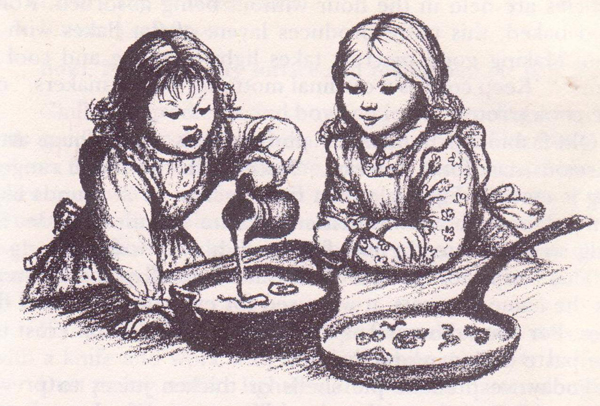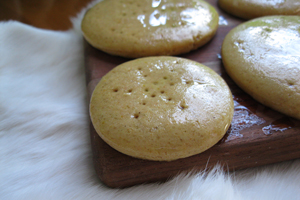Food in Fiction: How Cooking Brings You Closer to the Characters
Food is everywhere in series like The Boxcar Children, Game of Thrones, and Little House on the Prairie

HarperCollins
"One warm night four children stood in front of a bakery. No one knew them. No one knew where they had come from."
–opening lines of The Boxcar Children by Gertrude Chandler
This was one of the scenes in a book that first stuck with me when I was growing up: four homeless children standing in front of a bakery at twilight and debating whether to buy bread or cake with their dwindling supply of money. Food is everywhere in the Boxcar Children books, even after the Alden children find a home with their grandfather. They drink coconut milk on an island adventure; they marvel over enormous cookies; they cook enough chowder and baked beans to feed an entire coastal town during a festival. Those images were so tantalizing that it's not surprising that when I first learned to cook, it was from The Boxcar Children Cookbook, starting with a recipe for brownies that inspired the youngest Alden to reach out to a lonely local boy in The Lighthouse Mystery. I was never as hungry as the Aldens were when they were orphans, but baking those brownies gave me the powerful sense that I could be my own source of plenty. In the novel, they brought another character into the Aldens' orbit, and by recreating them, I stepped into that world as well.

Inn at the Crossroads
It wasn't until HBO's fantasy epic Game of Thrones started airing that I remembered the origins of my first solo cooking efforts. When a colleague invited me to a viewing party for the second episode, I tracked down Inn at the Crossroads—a food blog based on the dishes that show up in the George R.R. Martin books on which the show is based—so I could find a thematic dessert recipe. I selected lemon cakes, a recreation of the delicate favorite dessert of Sansa, the somewhat naive daughter of a noble house in the kingdom of Westeros. In the books, these cakes serve as a recurring symbol of her weakness for things that are beautiful and rich. The cakes weren't anything like I'd imagined from reading about them in the book—they were spongier and less sweet, and hard to imagine as a dreamed-of delicacy. But they were delicious, a powerful visceral connection to the people on screen and the world in which they live.
"The blog started as an accident," says Chelsea Monroe-Cassel, who cofounded Inn at the Crossroads with her friend Sariann Lehrer, neither of whom are professional cooks. "We both really like food, we like cooking, and we like the books."
It's easy to see why Martin would inspire Monroe-Cassel and Lehrer to take to their kitchens. By their count, he names more than 160 dishes in the four novels he's published in the Song of Fire and Ice series so far. And he uses food to signal everything from a character's disposition to plot developments: a phlegmatic and dangerous noble refuses alcohol; the northern guards of an ominous border wall, deprived of variety in their food supplies, become fussy about how they spice their wine; a Southern kingdom of warriors stokes the fires of their rage with spicy dishes; a feast careering towards disaster is so excessively lavish that it makes the participants physically ill in a way that matches their emotional unease. And looming over all these specific meals is the danger that a bad harvest may not last the nation throughout a hard winter.
"The food that Martin uses at certain key points in the book are important. Sansa's lemon cakes are indicative of her naivete at certain points in the books," Chelsea says. "If you look at the Red Wedding [a major tragedy in the third novel in Martin's series], the food descriptions are totally unappetizing."
She's right: The feast at that wedding—a political marriage contracted in the wake of a broken promise to unite two noble houses—consists of "a thin leek soup, followed by a salad of green beans, onions, and beets, river pike poached in almond milk, mounds of mashed turnips that were cold before they reached the table, jellied calves' brains, and a leche of stringy beef." And before the meal even begins, the main character is seated next to a man who "drank as if Westeros was about to run short of wine and sweated it all out under his arms." It's inedible-sounding food, eaten in nauseating circumstances, and it prepares readers for events they may not have the stomach for in a more metaphorical sense.
And Lehrer said that their research gave them a sense not just of how Martin signaled plot decisions and character traits, but of what real cultures and culinary traditions he used as models for his sprawling fictional society.
"I think the most interesting part is looking at the particular recipes that Martin picked and trying to figure out where in this wide world he pulled these recipes from," Lehrer said. "A lot of them turned out to be British ones."
She mentioned lamprey pie—yes, it's made of eels—which is eaten at a tense dinner by a brother who offers his sister some of every dish as insurance against the chance she might poison him.
"Lamprey pie is seated in East London, in very inexpensive pie shops," Lehrer said. "It's something they're trying to save [as a culinary form]."
Wendy McClure, by contrast, hasn't chopped up lampreys, but writing The Wilder Life, her exploration of Laura Ingalls Wilder's past, she did churn butter, fry salt pork, and try to capture the magic of Ma Ingalls' mythical vanity cakes. Paradoxically, McClure says, cooking her way through the recipes Laura relied on helped her understand the deprivations Laura suffered, both before and after her marriage.
"The modern part of yourself goes through the recipes, and you see the kind of lack of seasonings," she says. "There was no such thing as garlic in Ma Ingalls and [Laura Ingalls] Wilder's cooking. Even looking for recipes you might want to serve at a family meal or something, it's hard to find something that sounds really good."
And the sometimes lavish descriptions of food also helped McClure understand the extent to which the Little House books are a construction, and an attempt to cast a more positive light on the truly difficult things Laura Ingalls Wilder experienced as an adult.
"I had a really big revelation about the book Farmer Boy based on ... the food descriptions in the book," McClure says. "They were written by a woman about her husband after they had so many hard years together, trying to make a living off the land, and not very well sometimes."
There's something almost obscene about the plenty on the table at a dinner Almanzo Wilder and his family ate with company. His wife writes of that night:
There were slabs of tempting cheese, there was a plate of quivering headcheese; there were glass dishes of jams and jellies and preserves, and a tall pitcher of milk, and a steaming pan of baked beans with a crisp bit of fat pork in the crumbling brown crust ... Almanzo ate the sweet, mellow baked beans. He ate the bit of salt pork that melted like cream in his mouth. He ate mealy boiled potatoes, with brown ham-gravy. He ate the ham. He bit deep into velvety bread spread with sleek butter, and he ate the crisp golden crust. He demolished a tall heap of pale mashed turnips, and a hill of stewed yellow pumpkin. Then he sighed, and tucked his napkin deeper into the neckband of his red waist. And he ate plum preserves and strawberry jam, and grape jelly, and spiced watermelon-rind pickles.
In a more health-conscious, and less active age, it's hard to imagine eating that way, or needing to eat that way because you're burning so many calories through physical labor--and it's hard to imagine what it must be like to do the kind of work the characters in the Little House books do without reliably having enough to eat. But even though cooking her way through Little House recipes revealed Laura Ingalls Wilder's fantasies, and even though Ma's vanity cakes turned out to be just fairgrounds-variety fried dough, McClure says there was something powerful about eating the food that Laura ate.
"It really did feel like a little bit of time travel, like I can taste the same thing that these people in a little tiny building out in South Dakota in the middle of a terrible blizzard in 1881 experience," she says. "Even if it's just the sensation of this piece of bread in your mouth. That really captivated me."
As for The Boxcar Children Cookbook, McClure edits the series now, and says that she tells the writers who continued the series after creator Gertrude Chandler's death that the characters' encounters with food "have to be meaningful...I like to have them be involved in making it, in producing it." And beyond that series, she says she thinks cooking and food have powerful resonances for young readers, who may be better able to appreciate visceral descriptions without feelings of guilt about cost or anxiety about calories.
"Maybe that's the case with lots of children's literature, these scenes are a love letter to a time when enjoyment of food was simpler," McClure says. "Kids also do understand, food is a really great way to understand humanity, the experience of not having enough."
Fans may travel to conventions, dress up like their favorite characters, and learn to speak imaginary languages. But whether you're yearning for a quartet of orphaned children, tracking a sprawling fantasy saga, or imagining your way into the American past, there's nothing like a bite of something delicious but unusual to transport you to a place that you can only imagine.